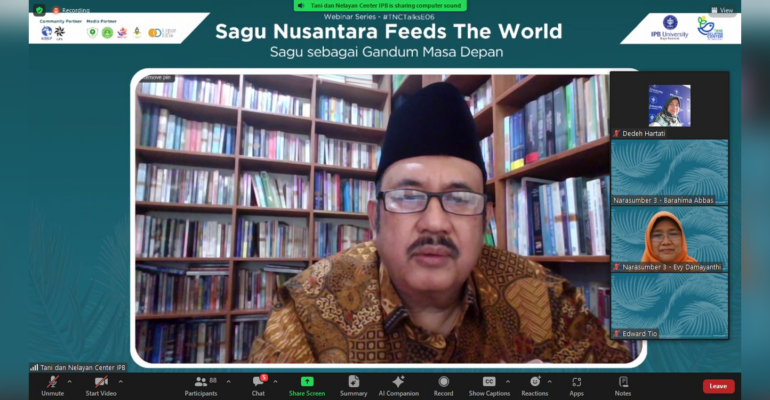TNC IPB University Webinar Series: Indonesia Can Feed the World with Sago

Sagu Nusantara Feed The World. That was the title of the Webinar Series held by the Farmers and Fishermen Center (TNC) IPB University on (25/9). Starting the event, Professor of Agronomy and Horticulture (AGH) IPB University, Prof Mochamad Hasjim Bintoro conveyed the great potential of national sago.
As one of the speakers, Prof Hasjim said that sago plants can produce 1,2 tonnes of productivity if managed properly and Indonesia is the largest country with 85 per cent of the world’s sago producers.
Prof Hasjim added that some farmers do not maintain the sago plant.
“Most farmers do not maintain sago, so the plant growth phase takes a little longer ranging from 8 to 10 years,” he added.
Meanwhile, Prof Evi Damayanti, Professor of the Faculty of Human Ecology, IPB University, discussed the nutritional content of sago. She emphasised that the Golden Generation 2045 can be achieved if we pay attention to important things, one of which is nutritional and health status.
She said that sago as a food has the privilege of being able to be processed into various shapes and forms. Sago also contains macronutrients that are very good for human health, namely the main source of carbohydrates.
“Sago also has bioactive components that can play a role for human health such as sera, resistant starch, low glycemic index and flavonoids,” she added. In addition, the sago plant also has advantages in the aspect of sustainability.
Meanwhile, Prof Barahima Abbas, Professor of the Faculty of Agricultural Technology, State University of Papua, conveyed the history and potential of sago. He said that sago is native to Papua and is the oldest food source in Papua. Sago has existed since 50.000 years ago, he said.
He added that for the people of Papua, sago is also part of the culture and belief system that is believed to bring glory and prosperity. However, according to him, there is still a gap between the potential and utilisation of sago for welfare.
“In addition, the potential and invention have been revealed by many experts and observers of sago. However, not much innovation and entrepreneurship has been rolled out to meet market needs,” he said.
He said it is a challenge to develop the sago industry when the locomotive of innovation is not fully available, entrepreneurship human resources (engineers and industry) are not many. On the other hand, the supporting infrastructure is not fully ready, the supply chain of sago starch raw materials is not sustainable, and the product marketing chain is not well established. Therefore, he emphasised that local and national investors need to be encouraged, triplehelix collaboration needs to be realised.
Responding to this, Prof Rachmat Pambudy, Professor of Agribusiness at IPB University, said that it is important for the central government to facilitate and properly manage Indonesia’s sago potential. This is because sago not only has economic strategic value, but also heritage and cultural value.
“Indonesia must make a short, medium and long term master plan for sago development. Sago is a wealth that can not only be utilised, but also inherited for posterity. I hope that the results of this webinar will be brought as recommendation material for the Minister of Investment / Chief of the Investment Coordinating Board (BKPM),” he said. (dh/Rz) (IAAS/RUM)



